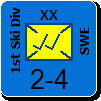We believe that "Option 50: (USSR-Japan compulsory peace)" is an important enough optional which was/is eventually to be implemented in MWIF that we decided at the start of our game to manually implement, if necessary, as written (above). And now it's necessary but we have a significant question to it's implementation.Option 50: (USSR-Japan compulsory peace) If Japan controls Vladivostok during the first war between Japan and the USSR, the Japanese player must agree to a peace if the Soviet player wants one. Similarly, if the USSR controls 3 or more resources that were
Japanese controlled at the start of Sep/Oct 1939, the Soviet player must agree to a peace if the Japanese player wants one. In either case, the new Russo-Japanese border is established by the hexes each controls. Any pocket of non-coastal hexes wholly surrounded by hexes controlled by the other major power becomes controlled by the major power whose hexes surround them.
Example :Hexes A and B are still Japanese controlled even though they are wholly surrounded by Soviet controlled hexes. If the USSR and Japan reach a peace, hexes A and B will become Soviet controlled.
The situation:
(1) USSR declared war on Japan on turn 5, May/June 1940.
(2) It's now turn 11, May/June 1941 and the USSR and Japan are still at war/fighting, it's the peace step and the axis player is considering forcing a peace.
(3) The USSR has taken, and controls, all of Manchuria and has captured 3 RPs that Japan controlled at the start of the game, hence the ability according the RAW above for Japan to force peace.
(4) The USSR has also advanced into northern China and has Peking, which is still Japanese controlled, completely surrounded.
(5) MWIF is showing the hexes in China "liberated" by the Soviets as Chinese controlled; however, the USSR was not asked nor has any intention of reverting control back to China during this first war with Japan.
The question/issue: Is MWIF correct? Or, should these hexes still be Soviet controlled?
The implication: Peking which is still Japanese controlled is surrounded by the Soviets. If peace is forced and these hexes are indeed Soviet controlled then Peking becomes Soviet controlled and those Chinese hexes liberated by the Soviets remain Soviet. However; if the surrounding hexes are Chinese controlled when peace is forced then Peking remains Japanese controlled and Japan could march back in/out of Peking. Even as I write this I'm confused as to what is correct according to WIF 7 Rules as Written. So any/all rules expertise is appreciated.










